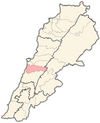Abey
Aabey
عبيه Abey | |
|---|---|
| Country | |
| Governorate | Mount Lebanon Governorate |
| District | Aley District |
| Elevation | 2,600 ft (800 m) |
| Population | |
• Total | 4,000 |
| Time zone | UTC+2 (EET) |
| • Summer (DST) | +3 |
Abey also spelled Aabey (Template:Lang-ar) is a largely Druze town[1] located in Mount Lebanon, in the Aley District of Mount Lebanon Governorate . It is located 22 km (14 mi) from Beirut and has an altitude of 800 m (2,600 ft). It is bordered by Kfarmatta (South), Bennay (East), Damour (West), and Ain Ksour (North). It overlooks Damour and the capital, Beirut, and the sea can be seen from virtually any point in the village. The highest point in AAbey is Mteyyar, where most of the surrounding villages can be seen, along with the east ridge of Lebanon's mountains and many of the southern towns of Lebanon.
Aabey is the birthplace of the diplomatic de:Fouad Bey Hamza (Template:Lang-ar) Saudi Arabia's Minister of Economic Development (1947-1952) in the reign of King Abdul Aziz Al Sa'ud. One of his famous books, "Al-Bilad Al-Arabia Al-Saudia".
Toufic Amin Hamze, Ambassador of Saudi Arabia in Paris and Ankara (1908–1933)
It is also noted Aabey being the home of Samir Kantar, a member of the Palestinian Liberation Organization, who was imprisoned for three decades in Israel after killing three people in a raid in the northern Israeli town of Nahariya. His return to Lebanon was marked by celebrations.[2][3]
Families of Aabey
Abey is rich in heritage and the families of Abey made undeniable charitable contributions. The main families in Aabey are Hamze, Haddad, Kenaan, Khoury, Ataya, Jamal, Jaber, Timani, Amine-Eddine Al-Tannoukh, Nakadi, Halabi, Nasr, Hassan, Raydan, Wehbe, Kuntar and Kanaan.
When Dr. Sami Makarem (Arabic: سامي مكارم) (April 14, 1931 - August 21, 2012) was asked about the source of the Tannoukh family name, his reply was that the word is an imperfect Arabic verb derived from the verb Nakh ناخ, only for him to ask for more enlightenment when he was asked if the word was built from two words Tan and Noukh otherwise symbolised by the rays of the sun handing the Ankh of Aten to the Pharaoh Amenhotep named Akhenaten referred to by the Druze as الشمس الجوهرية . The word of Akh اخ in Arabic means brother, and Aten اتن means the coming and the “en” Arabic letter ن represented by a concave symbol of a hand releasing the Ankh, or the two mountains from which the sun rises, or the sky which encompass the earth at noon time, all seem to be symbols of the coming of the brother of the sun. A concept which is not far from the coming of the Messiah. In addition to this the meaning of Amenhotep in Arabic الحتب امين is close to the concept of the guardian of the day of judgement. Hence Dr. Sami Makarem was asked could the name of Akhenaten mean the brother of the sun and the Tannoukh mean the brothers of the sun? The interpretation of these symbols is beyond the letter. The early believers of the coming of the Messiah used the Noon letter ن as the symbol of their faith which later became the cross. It is possible that the word for noon time is a carrier of this symbol. After Jesus some believers could not hold the cross as a symbol of love because the crucifiers meant it to be a torture weapon, instead they continued to use the letter Noon. Other believers considered it an honour to be crucified on a cross like Jesus and hence carried the cross. Effectively making it impossible for the torturer to use the cross to intimidate them psychologically. This explains why 'Sayyed Abdallah A-Tannoukhy' of Abey was highly appreciative of the Christian Cappucccines in Abey and their mission and Abey became the base of many Christian missionaries. The sun as a symbol rather than the symbol of the sun was refined by the reference to the Ra-ab Al-Ali-Mean, Guardian Father of the Highly Educated, compared to the Ra-ab Al-Ala-Mean, Guardian Father of the People upon which the message was placed but not necessarily carried by them. Hence the trinity of the Father, the Son and the Holy Spirit are closer in concept to the Ra the father of Ali and the Spirit of the Message, but not in the sense of father-son relationship but rather a rank where no one can equal the Guardian. When many of the Tannoukh family were killed Amine-Eddine امين الدين was spared and his decedents like Sheikh Ahmed Amine-Eddine A-Tannoukhy has trusted his properties to the Druze and lately Sheikh Halim Amine-Eddine A-Tannoukhy devoted his working life to the Druze trust and his wife Al-moqedima Maya Mezher Johnblat (the name that means Water for the Flowers of the Floor of John) with her home ruined by the outcome of the civil war, donated his inheritance from his cousin A-Sheikha Jamal Amine-Eddine A-Tannoukhya to the Druze trust.
Institutions: Cappucccine school, Monastery, Tannoukhy Palace, TNS, Gov. official school, Dawdye college, mihanye. Also the resting place of 'Sayyed Abdallah' A-Tannoukhy whose role in the Druze faith is mentioned by Philip Khuri Hitti.[4]
The families of Abey also include the families of Kanaan,[5] Haddad, Khoury, and Abou Nader.
References
- ^ Historical Dictionary of the Druzes by Samy Swayd
- ^ http://afp.google.com/article/ALeqM5h7rsGCXtisB5z_lcAvb2ErfAhHrA
- ^ https://www.france24.com/20080717-celebrations-lebanon-over-prisoner-swap-with-israel
- ^ The origins of the Druze people and religion, with ... v.28. Hitti, Philip Khuri, 1886-1978 (http://babel.hathitrust.org/cgi/pt?id=uc1.32106007583526)
- ^ http://canaan-abey.org/

